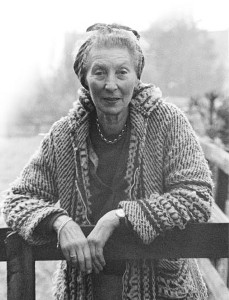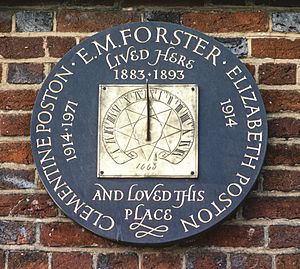Elizabeth Poston facts for kids
Elizabeth Poston (born October 24, 1905 – died March 18, 1987) was a gifted English composer, pianist, and writer. She created many pieces of music for radio and TV, and her Christmas carols are still very popular today.
Contents
Elizabeth's Early Life and Musical Start
Elizabeth Poston was born in a place called Highfield House in Pin Green, which is now a park in Stevenage. In 1914, when she was nine years old, she moved with her mother to a nearby house called Rooks Nest House. This house was special because the famous writer E. M. Forster had lived there as a child. Elizabeth and Forster became good friends.
Elizabeth was very musical from a young age. She went to Queen Margaret's School, York and learned piano from a teacher named Harold Samuel. Later, she studied at the Royal Academy of Music (RAM) in London. There, famous composers like Peter Warlock and Ralph Vaughan Williams saw her talent and encouraged her. She also studied how to compose music with Julius Harrison.
She won a prize from the RAM for a piece she wrote called a Violin Sonata. This piece was even played on the BBC radio in 1928! After she finished her studies in 1925, seven of her songs were published, and five more came out in 1928. Between 1930 and 1939, Elizabeth traveled a lot. She studied architecture and collected many traditional folksongs. She was also a skilled performer and was the first to play Walter Leigh’s Concertino for harpsichord and strings in 1934.
Working at the BBC During Wartime
When World War II began, Elizabeth came back to England. She joined the BBC, which is a big broadcasting company, and became the director of music for their European Service. During the war, she was said to have done some special, secret work. It's believed she used gramophone records to send secret messages to allies in Europe. She also played the piano at special lunchtime concerts held at the National Gallery during the war.
Elizabeth left the BBC for a short time in 1945. But she returned in 1946 when she was asked to help create a new radio station called the BBC Third Programme. She was one of the youngest composers to have her music played on this new station when it opened. She wrote music for a play called Comus by John Milton.
Composing Music for Radio and TV
Elizabeth Poston wrote music for many radio and television shows – over 40 for radio alone! She worked with famous writers like C. S. Lewis and Dylan Thomas. She even wrote the music for a 1970 BBC TV show of Howards End while living in Rooks Nest House, which was the actual setting for the story!
One of her important pieces, The Nativity (1950), was first a radio show. But it later became a longer piece for choirs to perform in concerts. Another choral piece she wrote is called An English Day Book. This is a 20-minute collection of songs based on poems about different times of the day and year. It includes a popular song called Sweet Suffolk Owl.
Elizabeth also wrote music for small groups of instruments. Her Concertino da camera on a Theme of Martin Peerson (1957) is a good example. A recording of her 1960 Trio for flute, viola, and harp can be found online, and a new recording was released in 2021. She also wrote a short piece for string orchestra called Blackberry Fold: Requiem for a Dog, which was first played on the radio in 1976.
Her carols, especially "Jesus Christ the Apple Tree" (1967), are still sung very often, especially around Christmas. Elizabeth wrote over 300 pieces of music in total, and some are still being discovered today! Her large collection of works is kept at the Hertfordshire Archives and Local Studies in Hertford.
Writing and Editing Books
Besides composing, Elizabeth Poston was also a smart academic, writer, and editor. In 1947, she gave a series of five lectures on the composer Peter Warlock for the BBC. Later, she even defended his reputation in a very personal radio talk.
She wrote articles and notes for the Arts Council of Great Britain. She also edited many collections of vocal music. One of these was The Children's Song Book (1961). She said this book was "a little autobiography," showing her own love for songs since she was just two years old. The book included five of her own songs, including a short version of Jesus Christ the Apple Tree. This short song later grew into her famous choral piece.
Elizabeth also helped create three books for Penguin Books. These were The Penguin Book of Christmas Carols (two volumes, 1965 and 1971) and, with Alan Lomax, The Penguin Book of American Folksongs (1964). She also worked with David Holbrook on The Cambridge Hymnal (1970).
Later Life and Legacy
Elizabeth Poston was the president of the Society of Women Musicians from 1955 to 1961. She continued to live at Rooks Nest House until she passed away in 1987 at the age of 81.
In 2018, a list of her works was published by her friend Dr. John Alabaster. It showed that about two dozen of her compositions were thought to be lost. But one of them, the Festal Te Deum, which was first performed in 1959, was happily found again in 2018!



